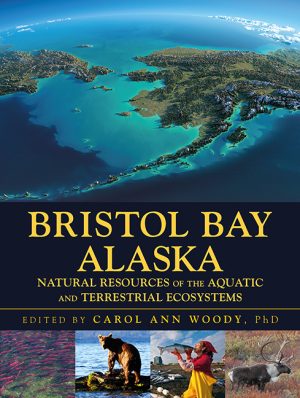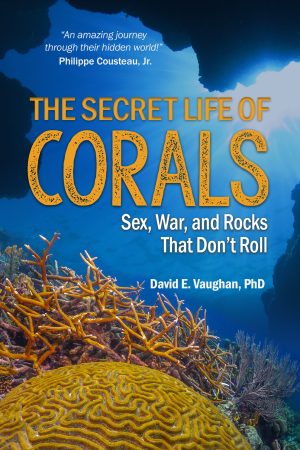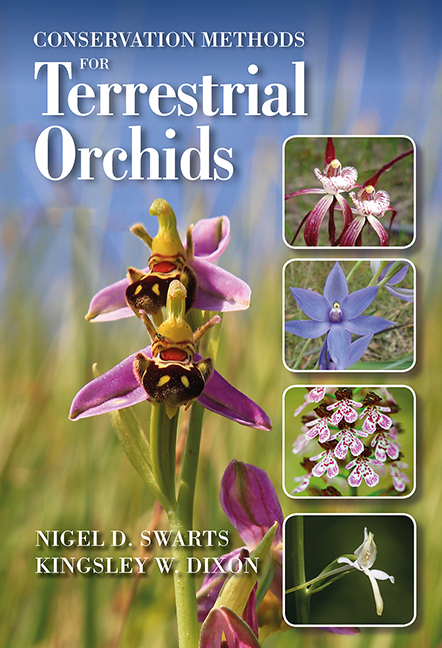Conservation Methods for Terrestrial Orchids
$59.95
Nigel Swarts, Ph.D., and Kingsley W. Dixon, Ph.D.
Hardcover, 7×10, 240 pages
ISBN: 978-160427-123-2
June 2017
Description
Orchids are unmatched in their floristic diversity, wide range of growth habitats, and, most importantly, their unique and highly adapted biology and ecology. With terrestrial orchids now among the world’s most threatened plants, the need for conservation is paramount. Conservation Methods for Terrestrial Orchids equips orchid biologists, botanists, conservationists, students, and hobbyists with the necessary methodologies to facilitate the conservation of this endangered group of orchids.
This first-ever comprehensive volume on terrestrial orchids includes background information, techniques, procedures, and relevant case studies on topics such as monitoring, approaches used for mycorrhizal isolation and culture, seed sowing techniques, soil baiting, symbiotic culture of terrestrial species, translocation of propagated plants, pollination, genetic approaches for orchid biology and conservation, innovations in alginate encapsulation of seed and mycorrhizal fungus, and more. The focus of this volume is on terrestrial orchids as these species face the greatest conservation threats, however, the techniques described in this book can also be applied equally to epiphytic (tree) orchids.
Key Features
- Clearly and concisely explains the procedures necessary for terrestrial orchid conservation and restoration
- Offers methods and techniques complete in their detail, utilization of modern technology, simplicity, and ease of application across species from different parts of the world
- Features beautiful color illustrations and photographs outlining procedures and concepts
- Provides stand-alone guidance in each chapter and collectively enables practitioners to undertake what were previously considered complex scientific procedures
- Includes relevant case studies to illustrate key principles and success stories in orchid conservation, written by world leaders in orchid conservation practice and science
- Relates many of the techniques and procedures to epiphytic orchids to increase the appeal of the book to all orchid conservationists
About the author(s)
Nigel Swarts, Ph.D.
Introduced to the orchids of the Swan Coastal Plain in Perth, Western Australia by his father, Nigel developed a keen interest in the Orchidaceae. The re-discovery of a threatened spider orchid in bushland close to his childhood home paved the way for a future in orchid conservation research. Nigel received his undergraduate degree in Environmental Biology at Curtin University. He then completed his Ph.D. with distinction on the conservation of critically endangered orchids at the University of Western Australia. Nigel’s research has led to a better understanding of the role of mycorrhizal specialization in the ecology and rarity of the Orchidaceae. His work has contributed to the development of new approaches to the conservation and recovery of terrestrial orchids based on key biological and ecological requirements for orchid survival.
During his first post-doc, Nigel embarked on an ambitious project to conserve all of Western Australia’s terrestrial orchid seed and fungi in perpetuity. Nigel managed the orchid research programs of the Kings Park Botanic Gardens, supervised students, and trained teams of volunteers in the ex situ culture and propagation of Western Australian orchids using many of the techniques described in this book. In 2009, Nigel moved to Tasmania and established a similar orchid conservation and research program at the Royal Tasmanian Botanical Gardens focusing on Tasmanian endemic species. He runs an ex situ conservation program where volunteers are trained in orchid conservation and propagation methods. He authored the multi-species recovery plan for all Tasmania’s threatened orchid species and continues his research into the mycorrhizal relationships of Australian terrestrial orchids on a part-time basis.
Nigel is currently a Research Fellow at the Tasmanian Institute of Agriculture at the University of Tasmania. In addition to his research, Nigel supervises graduate students in topics ranging from tree physiology to cider production and terrestrial orchid ecology. Nigel is also an active member of the Tasmanian Threatened Species Committee.
Kingsley Dixon, Ph.D.
Kingsley Dixon is the Curtin University Professor at Kings Park and Botanic Garden in Perth, Western Australia. He is one of Australia’s leading botanists who found his passion for orchids as a small child and would often collect them with his parents on bush walks. His professional and scientific interests in orchids developed while obtaining his Ph.D. at The University of Western Australia when he worked on the ecology of native southwest Australian orchids. Later, he expanded this into propagation, mycorrhizal, pollination, and conservation research when he established the world-acclaimed Kings Park Botanical Research Facility in the State Botanic Garden in Western Australia. Since then, Kings Park has produced more than 60 Ph.D.’s in botany and the biological sciences, and is home to an internationally recognized orchid research group that has made many major advances including the development of novel tissue culture procedures for rare orchids and the first cryo-banking methodology for rare orchid seed. Kingsley was hired by Curtin University in 2015 and continues to lead major conservation and restoration programs that include orchid biology, ecology, and conservation research.
Kingsley has developed extensive research collaborations in conservation and restoration science in China, Southeast Asia, Europe, and the Americas. This has included programs to save rare and threatened slipper orchids in Indonesia and developing conservation propagation of European rare terrestrial orchids. Through these partnerships, he has developed a global network of orchid researchers and collaborators that includes significant input from citizen science programs from local to international orchid groups, including the Hardy Orchid Society of the United Kingdom.
With an incredible drive and enthusiasm for conservation and restoration of native ecosystems in Australia and around the world, Kingsley has published over 400 peer reviewed papers and 13 books, and has been recognized with several awards, including the Australian Orchid Foundation Award of Honour, the international Linnean Medal in Botany, and the Western Australian Scientist of the Year (2016/17). His passion for orchids and their conservation led him to establish the well-known International Orchid Conservation Congress series in 2001. Currently, Kingsley holds positions on international boards and commissions, including co-chair of the Orchid Specialist Group of the IUCN, Chair of the Research Committee of the Australian Orchid Foundation, Chair of the International Network for Seed-based Restoration, Chair of the Society for Ecological Restoration Australasia, and Board member of the Society for Ecological Restoration.
Table of Contents
Chapter 1: Introduction to Orchid Conservation
Why Are Orchids Rare?
What this Book Means to Orchid Conservation
Chapter Outlines
Epilogue on the Future of Orchid Conservation
Chapter 2: In Situ Monitoring, Demographics, and Conservation Instruments
2.1 Background
2.2 Monitoring Methods
2.2.1 Permanent Pegs
2.2.2 Transect Method
2.2.3 Plot Method
2.2.4 Mapping and Recording Orchid Recruitment
Case Study 2.1
2.3 Essential Parameters in Demographic Studies
Case Study 2.2
Case Study 2.3
2.4 Photo Points as Tools in Monitoring
Case Study 2.4
2.5 Recovery Plans for Terrestrial Orchids
2.6 International Conservation Instruments
2.6.1 How the Red Listing Process Works
Chapter 3: Orchid Mycorrhizal Associations
3.1 Background
3.2 Orchid Mycorrhizal Dependency and Nutrition
Case Study 3.1
3.3 Identity and Specificity
Case Study 3.2
3.4 Achlorophyllous Orchids
3.5 Orchid Mycorrhizal Methods
3.6 Fungal Culture Isolations
3.6.1 Plant Material Collection
Procedure 3.1
3.6.2 Surface Sterilization
3.6.3 Isolation of Pelotons
Procedure 3.2
3.7 Mycorrhizal Culture Growth and Storage
Procedure 3.3
3.8 Media for Fungal Culture
Procedure 3.4
Procedure 3.5
Procedure 3.6
Procedure 3.7
Procedure 3.8
Procedure 3.9
Chapter 4: Orchid Seed Germination Techniques
4.1 Background
4.2 Mycorrhizal Fungi for Seed Germination of Terrestrial Orchids
4.3 Properties of Orchid Seeds
4.4 Hand Pollination for Seed Production
4.5 Seed Collection
Procedure 4.1
4.6 Sowing Mature Seed
Case Study 4.1
4.6.1 Seed Viability Staining
Procedure 4.2
Case Study 4.2
4.6.2 Sterilants
Case Study 4.3
4.6.3 Stages of Seed Germination
4.6.4 Seed sowing—Packet Method
Procedure 4.3
4.6.5 Seed Sowing—Syringe Method
Procedure 4.4
4.6.6 Seed Sowing—Direct Sterilization
Procedure 4.5
4.7 Sowing Techniques for Immature Seed
Procedure 4.6
Case Study 4.4
Chapter 5: Assessing Mycorrhiza in Soil
5.1 Background
5.2 Mycorrhizal Specificity in Soil
5.3 Recruitment Limitation
5.4 Distribution of Mycorrhiza in Soils
5.5 Niche Exploitation and Competition
5.6 In Situ Seed Baiting Methods
5.6.1 The Slide Frame Baiting Method
Procedure 5.1
Case Study 5.1
5.6.2 Nylon Mesh In Situ Seed Baiting
Procedure 5.2
5.6.3 Seed baiting for epiphytic orchids
Case Study 5.2
5.6.4 Seed Germination in Retrieved Soil
Procedure 5.3
Chapter 6: Orchid Culture for Conservation
6.1 Background
6.2 Symbiotic Orchid Propagation
6.3 Seedling Development
Case Study 6.1
6.4 Transfer to Soil Mix
6.4.1 Sand/Vermiculite over Agar Growth Containers
Procedure 6.1
6.5 Pot cultivation
6.5.1 Requirements for Growing Terrestrial Orchids
Case Study 6.2
6.5.2 Potting Mixes
6.5.3 Pasteurizing Potting Mixes
6.5.4 Growing Conditions
6.5.5 Disease and Pest Control
6.5.6 Repotting of Terrestrial Orchids
Procedure 6.2
6.6 Direct Seeding
6.6.1 Inoculating Potting Mix
Procedure 6.3
6.6.2 Mature Plants
Chapter 7: Herbaceous Terrestrial Orchid Translocation
7.1 Background
7.2 Requirements for Successful Orchid Translocation
7.3 Propagation for Translocation
Case Study 7.1
7.4 Assisted Migration
7.5 Framework for Translocation Projects
7.6 Restoring Habitats Suitable for Orchids
Case Study 7.2
7.7 Methods for Terrestrial Orchid Translocation
7.7.1 Out-planting Juvenile Herbaceous Terrestrial Orchids
Case Study 7.3
7.7.2 Out-planting by Tuber/Rhizome Transfer
7.7.3 In Situ Seed Sowing
Case Study 7.4
7.7.4 Transplanting Mature Wild Plants
7.8 Pre- and Post-translocation Surveying and Monitoring
Case Study 7.5
Chapter 8: Orchid Pollination
8.1 Background
8.2 Pollinator Limitation
8.2.1 Testing for Pollination Limitation
8.2.2 Resource Limitation
8.3 Pollination Strategies
8.3.1 Pollination by Reward (Food Advertisement)
8.3.2 Pollination by Deception
8.3.3 Food Deception
Case Study 8.1
8.3.4 Sexual Deception
Case Study 8.2
8.4 Pollinator Inferences in Conservation Planning
8.5 Pollinator Chemistry
Chapter 9: Genetic Techniques in Orchid Conservation
9.1 Background
9.2 Population Genetics
9.2.1 Principal Population Genetic Markers for Conservation
9.3 Molecular Phylogenetics/Systematics
Case Study 9.1
Case Study 9.2
9.4 Quantitative Genetics
9.5 Mycorrhizal Specificity in Orchid Populations
9.6 Considerations in Undertaking a Conservation Genetics Study
9.7 Scoring Molecular Data
9.8 Analysis of Data
Case Study 9.3
9.9 Technical Notes: DNA Extraction
Procedure 9.1
Procedure 9.2
9.9.1 DNA Extraction of Mycorrhizal Fungi
Chapter 10: Storage of Orchid Seed and Mycorrhiza
10.1 Background
10.2 Securing Collections of High Conservation Value
10.3 Seed Quality
10.4 Orchid Seedbanking
Case Study 10.1
10.5 Vouchering Specimens
10.6 Genetic Considerations in Seed Collection Programs
10.7 Living Collections as an Ex Situ Conservation Tool
Procedure 10.1
10.8 Long-term Storage of Orchid-mycorrhizal Fungi
Case Study 10.2
Procedure 10.2
10.9 Alginate Encapsulation of Orchid Seed and Fungus
Procedure 10.3
Chapter 11: References
Reviews
“This authoritative and magnificent book is the work of many years of two well-respected scientists in the field, who clearly share a lifetime passion for terrestrial orchids. It describes breakthrough orchid research that now makes it possible to propagate even the most recalcitrant of species. This book includes case studies of conservation success and technology advances written by experts in their field from around the world.”
—From the Foreword by Sir David Attenborough
“This not just a jewel of a book, it is a treasure house of useful information and while definitely written with the professional botanist/ecologist/orchid conservationist in mind, it is an extraordinarily educational read for anyone interested in acquiring knowledge about orchids.”
—Henry Oakeley, from a review in the Journal of the Orchid Society of Great Britain
“This is a fascinating book filled with cogent information aimed at making orchid conservation technology accessible to all interested people (not just scientists).”
—Leon Glicenstein, Book Review in Orchids, the Bulletin of the American Orchid society
“The outstanding features of the book include high quality photographs and illustrations. There are concise outlines of methods and techniques involving a wide range of species. There is also an easy readability and understandable approach that conveys the enthusiasm and experience of the authors.”
—Peter B. Adams, Book Review in the Orchadian, the Journal of the Australasian Native Orchid Society
“Conservation Methods for Terrestrial Orchids is an ambitious book that sets out to demystify the many facets of orchid science in an accessible manner. It succeeds superbly.”
—Tom McCarter, Book Review in the BOTANIC GARDENer, the magazine for botanic garden professionals.
“The authors have done the orchid world a great service by creating a book that will transfer their knowledge to a much wider global audience.”
—Mike Gasson, Book Review in the Journal of the Hardy Orchid Society
“The ability to put this book together so that the information is informative as well as readable is astounding.”
—Coralie Hills, Editor of Orchids Australia, the official publication of the Australian Orchid Council, Inc.
Related products
-

Geotechnical Engineering Handbook
Retail Price: $129.95$109.95 Add to cart -

Bristol Bay Alaska
Retail Price: $97.50$84.95 Add to cart -

The Secret Life of Corals
Retail Price: $29.95$27.95 Add to cart -

Real People Real Recovery
Retail Price: $24.95$21.95 Add to cart -

Architectural Acoustics
Retail Price: $64.95$54.95 Add to cart

